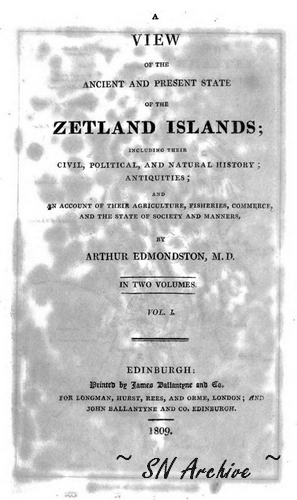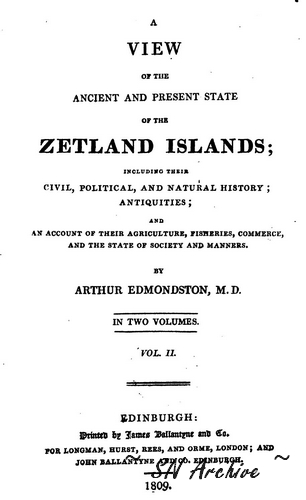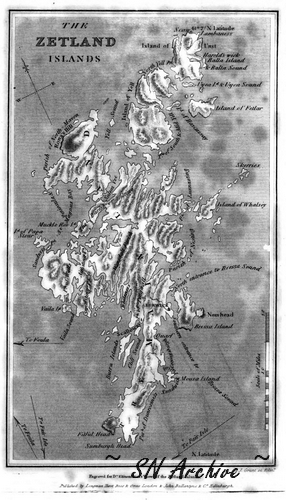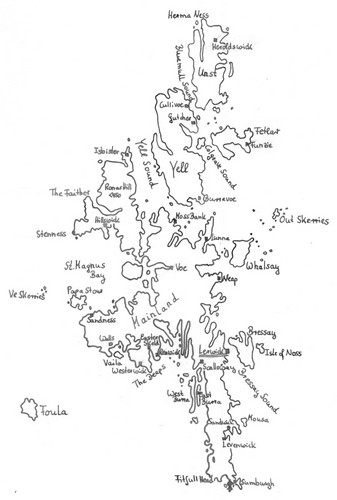  |
A View Of The Ancient And Present State Of The Zetland Islands Vol. I & II Including Their Civil, Political, And Natural History; Antiquities; And An Account Of Their Agriculture, Fisheries, Commerce, And The State Of Society And Manners Arthur Edmonston, M.D., printed by James Ballantyne and Co., Edinburgh (GB) (Digitized by Google) |
Vol. I "Preface.
-----
... The Zetland Islands, although they have long constituted an integral part of Great Britain, and their utility to it, especially in a maritime point of view, be obvious and acknowledged; yet their productions, resources, and internal economy, are less generally known than those of the most distant colony of the empire. ...
Zetland has been known by the different appellations of Hethland, Hialtland, Zetland, Schetland, and Shetland. The words are of Norwegian origin, and are supposed to be descriptive of its form or appearance. ..."
Vol. II "Page 205-226: SECTION IV.
Zoological Observations.
As the living objects which Zetland presents are comparatively few in the number of genera, I shall arrange them rather according to the known habits of the individuals, than in conformity with the arbitrary classification of naturalists. In the division which comprehends the quadrupeds, I shall include those only which exist on, and derive their food from the dry land. ....
Quadrupeds.
THE quadrupeds are few in number, and of the kinds most generally known. The following are all that Zetland affords; the horse, ox, sheep, hog, dog, cat, rat, mouse, rabbit, and ferret.
OVIS ARIES, (Lin. syst.) Sheep.- The sheep is very small compared with those of the southern parts of Scotland and England, the carcase not weighing on an average more than thirty pounds. They have short tails and small horns, and the ears stand erect. They are of different colours: a white, grey, black, speckled, and of a dusky brown called moorit. The grey is the most prevailing colour. The quality of the wool varies very much, even on the same animal; the thighs and rump yielding the coarsest, and the neck and breast the finest wool. The sheep yean in the months of April and May, and generally drop one lamp each. It is by no means unusual for a ewe to drop two lambs, and some have had three; but this latter is rather an uncommon occurrence.
The sheep in Zetland all run wild in the hills. The different owners know those which belong to them by a mark on the ear, and the people can discriminate slight differences of this kind with wonderful ease and accuracy, even at a great distance off. In summer, they are generally driven into a small circular enclosure called a crue, for the purpose of taking off the wool. The native sheep are seldom shorn, but about the middle of May, when the fleece begins to loosen spondaneously, it is pulled off with the hand. This operation is called rooing the sheep. They are left very bare after it; but the people say, that the wool on the animal continues much finer when removed in this manner, than by the shears. Except for the purpose of rooing, weaning, and marking them, in all other occasions the sheep are caught by dogs trained for the purpose. It is surprising with what accuarcy they single out a sheep from among a flock; and in a short time the individuals who are not the objects of pursuit, appear to be sensible of the election in their favour, and become comparatively tranquil, while the other is hunted down.
The sheep are never taken under cover in the winter time, nor, in case of snow, is there any food provided for them. On this latter account they suffer greatly, having little else to feed upon, for weeks in succession, but the sea-weed growing on the shores, or what has been drifted on the beach by the surf. It is curious to observe with what precision they leave the hills and betake themselves to the sea-side at the moment the tide of ebb commences. ...
On the coming on of a storm of snow they retire to the more sheltered places, which are generally in the neighbourhood of the sea. ...
CANIS FAMILIARIS, (Lin. syst.) Dog.- The dog is of the shepherd dog kind. Dogs are very abundant in the Zetland islands. They are extremely versatile, and when well trained, can either catch sheep, or water with the gun. They are sagacious, watchful, and affectionate, and are seldom restrained in their personal liberty by the dread of hydrophobia. Sonnini remarks, that neither in Egypt, where dogs are treated with the greatest harshness, nor in the hottest zones of Africa or America, is canine madness knwon.* This observation contradicts the fallacious opinion, which supposes it to be a disease either of hot cilimates or seasons.
* Voyage en Egypte, tom. i."
If you discover any errors in the text that may have been caused by the transcription, please let us know for a prompt correction.

